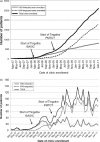Improved identification and enrolment into care of HIV-exposed and -infected infants and children following a community health worker intervention in Lilongwe, Malawi
- PMID: 25571857
- PMCID: PMC4287633
- DOI: 10.7448/IAS.18.1.19305
Improved identification and enrolment into care of HIV-exposed and -infected infants and children following a community health worker intervention in Lilongwe, Malawi
Abstract
Background: Early identification and entry into care is critical to reducing morbidity and mortality in children with HIV. The objective of this report is to describe the impact of the Tingathe programme, which utilizes community health workers (CHWs) to improve identification and enrolment into care of HIV-exposed and -infected infants and children.
Methods: Three programme phases are described. During the first phase, Mentorship Only (MO) (March 2007-February 2008) on-site clinical mentorship on paediatric HIV care was provided. In the second phase, Tingathe-Basic (March 2008-February 2009), CHWs provided HIV testing and counselling to improve case finding of HIV-exposed and -infected children. In the final phase, Tingathe-PMTCT (prevention of mother-to-child transmission) (March 2009-February 2011), CHWs were also assigned to HIV-positive pregnant women to improve mother-infant retention in care. We reviewed routinely collected programme data from HIV testing registers, patient mastercards and clinic attendance registers from March 2005 to March 2011.
Results: During MO, 42 children (38 HIV-infected and 4 HIV-exposed) were active in care. During Tingathe-Basic, 238 HIV-infected children (HIC) were newly enrolled, a six-fold increase in rate of enrolment from 3.2 to 19.8 per month. The number of HIV-exposed infants (HEI) increased from 4 to 118. During Tingathe-PMTCT, 526 HIC were newly enrolled over 24 months, at a rate of 21.9 patients per month. There was also a seven-fold increase in the average number of exposed infants enrolled per month (9.5-70 patients per month), resulting in 1667 enrolled with a younger median age at enrolment (5.2 vs. 2.5 months; p < 0.001). During the Tingathe-Basic and Tingathe-PMTCT periods, CHWs conducted 44,388 rapid HIV tests, 7658 (17.3%) in children aged 18 months to 15 years; 351 (4.6%) tested HIV-positive. Over this time, 1781 HEI were enrolled, with 102 (5.7%) found HIV-infected by positive PCR. Additional HIC entered care through various mechanisms (including positive linkage by CHWs and transfer-ins) such that by February 2011, a total of 866 HIC were receiving care, a 23-fold increase from 2008.
Conclusions: A multipronged approach utilizing CHWs to conduct HIV testing, link HIC into care and provide support to PMTCT mothers can dramatically improve the identification and enrolment into care of HIV-exposed and -infected children.
Keywords: Africa; HIV; HIV-exposed infants; case finding; children; community health workers; linkage to care; paediatrics.
Figures



References
-
- UNAIDS. Geneva, Switzerland: Joint United Nations Programme on HIV/AIDS; 2011. Countdown to zero: global plan towards the elimination of new HIV infections among children by 2015 and keeping their mothers alive.
-
- Creek TL, Sherman GG, Nkengasong J, Lu L, Finkbeiner T, Fowler MG, et al. Infant human immunodeficiency virus diagnosis in resource-limited settings: issues, technologies, and country experiences. Am J Obstet Gynecol. 2007;197(Suppl 3):S64–71. - PubMed
-
- Sherman GG, Cooper PA, Coovadia AH, Puren AJ, Jones SA, Mokhachane M, et al. Polymerase chain reaction for diagnosis of human immunodeficiency virus infection in infancy in low resource settings. Pediatr Infect Dis J. 2005;24(11):993–7. - PubMed
-
- Chintu C, Bhat GJ, Walker AS, Mulenga V, Sinyinza F, Lishimpi K, et al. Co-trimoxazole as prophylaxis against opportunistic infections in HIV-infected Zambian children (CHAP): a double-blind randomised placebo-controlled trial. Lancet. 2004;364(9448):1865–71. - PubMed
Publication types
MeSH terms
Grants and funding
LinkOut - more resources
Full Text Sources
Medical

